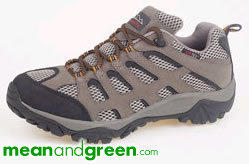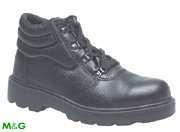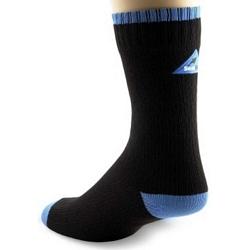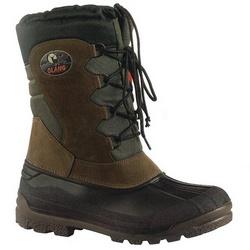Fishing Boots Check List
OK, you’ve found the fishing-boots.co.uk website, browsed all the different sections to see what’s on offer, and now you’re ready to spend some of your heard earned – but which type of boot is best for you, and do you need more than one pair? In this special piece we’ve asked Julian Grattidge to detail the different types of footwear he uses throughout the year in pursuit of specimen carp;
Depending on the type of fishing you do, and when you do it, you might need a few different types of footwear to help keep you in touch with the quarry. I’m a stalking angler at heart, and I’m never happier than when I’m up a tree waiting for my next fat adversary to swim into view. As such, I like being very surefooted on the bank, so large, bulky, cumbersome boots are out for the main part. I try to get away with the lightest footwear possible.
 Ultimately, the footwear I choose will be dictated by the water itself and the time of year. From spring through to late autumn I like to wear low cut boots for most of my fishing, be it overnight session fishing or short sessions for just a few hours at a time. My low cut boots are effectively heavyweight trainers, which allow excellent flexibility when climbing trees and have an excellent grip to gain good purchase on the countless terrains I’ll encounter when I’m out fishing on different waters. The Johnscliffe Waterproof Shoe is a perfect example of this type of low cut boot and I find them excellent for my all-round fishing needs for most of the year.
Ultimately, the footwear I choose will be dictated by the water itself and the time of year. From spring through to late autumn I like to wear low cut boots for most of my fishing, be it overnight session fishing or short sessions for just a few hours at a time. My low cut boots are effectively heavyweight trainers, which allow excellent flexibility when climbing trees and have an excellent grip to gain good purchase on the countless terrains I’ll encounter when I’m out fishing on different waters. The Johnscliffe Waterproof Shoe is a perfect example of this type of low cut boot and I find them excellent for my all-round fishing needs for most of the year.
Depending on the water, I may also have my waders with me. I do like to get out into the water whenever possible as there are things you can learn from feeling underfoot that you just cannot pick up with even the best feature finding set up. I have a pair of PVC thigh waders and a pair of 4mm neoprene chest waders. Some waters I fish have very steep margins, immediately going down to over chest wader height or heavy silt which would again sink over my chesties, so it’s pointless wearing them, but on waters where you can access shallow marginal or open water areas I swear by my waders, and often use them to wade out baits and free offerings, clear little spots not seen from the bank, and generally take time to go out and get the best presentation of the hookbait possible. Actually getting out into the lake will bring you such a greater understanding of what’s going on that it just can’t help but put you more fish on the bank!
 If it’s a water where I might just bob in and out to marginal areas or to net or return a fish, I’ll just take my thigh waders. If I know I’m going to be wading twenty or more yards out from the swim, then obviously I’ll take my chesties. Just one bug bear here too which really annoys me; the amount of anglers who will set up on a known shallow swim without the appropriate footwear, who will then effectively drag a hooked fish through inches of water to net it! Just get a pair of waders, walk out and scoop it up! Not only does this reduce the risk of damage to the fish but it reduces the risk of that last minute bid for freedom as you’re bent at full stretch trying to manoeuvre it over the net cord… be prepared is the bottom line!
If it’s a water where I might just bob in and out to marginal areas or to net or return a fish, I’ll just take my thigh waders. If I know I’m going to be wading twenty or more yards out from the swim, then obviously I’ll take my chesties. Just one bug bear here too which really annoys me; the amount of anglers who will set up on a known shallow swim without the appropriate footwear, who will then effectively drag a hooked fish through inches of water to net it! Just get a pair of waders, walk out and scoop it up! Not only does this reduce the risk of damage to the fish but it reduces the risk of that last minute bid for freedom as you’re bent at full stretch trying to manoeuvre it over the net cord… be prepared is the bottom line!
There are countless types to choose from, my preference is for a bootfoot chest wader with cleated sole, and the Greys Neoprene Bootfoot Fishing Waders are a perfect example. That said, I do go for very cheap waders. I’m always crawling through bushes and god knows what else in search of my quarry so they don’t tend to last too long. Add to that I’m involved with running two syndicate waters as well so they get used for quite a lot of work in and around the lakes.
Come the colder months I’ll switch to a mid cut boot. I try to leave the switch as long as possible, and it’s only when the frosts come and daytime temps are below ten degrees that I’ll finally leave the low cut boots at home. That said, on bright cold days I might still get away with the low cut boots as I always wear any fishing footwear with my SealSkinz Mid-Thermal Merino Socks – essential kit for any angler.
 Again, due to the fact that I’m working on the lakes a lot, I tend to go for a safety type boot. Twinned with the SealSkinz socks I get as good insulating and wicking qualities as I would with any other type of thermal boot, but with the added protection of a steel toe cap and thick protective sole. Safety boots have come a long way, and the lightweight versions available today are a far cry from those many will have used in the past – and what’s more, they are often much cheaper than normal branded boots. The Grafter Chukka Safety Boot is a good example.
Again, due to the fact that I’m working on the lakes a lot, I tend to go for a safety type boot. Twinned with the SealSkinz socks I get as good insulating and wicking qualities as I would with any other type of thermal boot, but with the added protection of a steel toe cap and thick protective sole. Safety boots have come a long way, and the lightweight versions available today are a far cry from those many will have used in the past – and what’s more, they are often much cheaper than normal branded boots. The Grafter Chukka Safety Boot is a good example.
When the temperatures drop below zero, it’s time to bring out my field boots. These are heavy duty waterproof boots with a removable thermal liner. Great for cold sessions on the bank and my three times a week feeding trips to the lakes. Brrrrrrr. There are a few different types available, but my preferred choice is one with a rubberised base and laced upper walls. The Olang Canadian Après Ski Boot is a great example of a quality winter boot that will keep your feet warm on long sessions. I’m all for saving a few quid where I can, but when it comes to a decent winter boot it’s worth spending a few extra quid – your feet will thank you for it!
Julian Grattidge
January 2011

